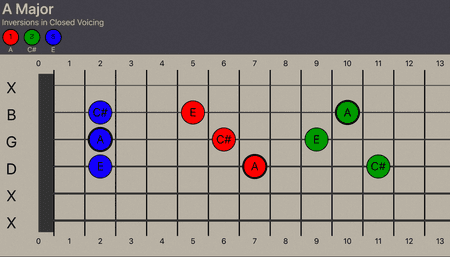![Fingerstyle Picking Using Four-Note Triads In Closed Voicing Along The String.]()
Fingerstyle Picking Using Four-Note Triads In Closed Voicing Along The String.
This article continues similarly to Alternate Picking Using Three-Note Triads In Close Voicing Along The String. (See that article for a more thorough overview of the fundamental concepts.) Instead of using three-note chord inversions in close voicing, this post will focus on utilising a four-note chord, with one of the notes in the chord doubled up. Allowing […]
![Alternate Picking Using Three-Note Triads In Closed Voicing Along The Strings.]()
Alternate Picking Using Three-Note Triads In Closed Voicing Along The Strings.
This article intends to help those who are comfortable moving between three-note closed voicing inversions along the length of the strings, but desire more interesting practice applications. In and of itself, moving between each inversion (as explained here) isn’t particularly interesting, creative or fun to practice. Hopefully, the ideas discussed throughout this post will help […]
![Harmonising Triad Pairs In Open Voicing]()
Harmonising Triad Pairs In Open Voicing
What is “open” voicing? “Open voicing” is the term used to describe a chord where the notes have large intervallic gaps. Utilising Triad Pairs In Open Voicing provides a great way to double the amount of ground when practicing and developing Triads. If you want to find out more about the theory registered users can […]
![Harmonising Hexatonic Scales Into A Pair Of Triads]()
Harmonising Hexatonic Scales Into A Pair Of Triads
What and Why Triad Pairs? Harmonising hexatonic scales into a triad pairs provides a fantastic concept for expanding on knowledge of triads and diatonic harmony and find new and intriguing ways of exploring the fretboard. They’re a particularly useful tool for improving triad technique as the physical patterns are similar to their three-note triad counterparts. […]
![Harmonising Diatonic Scales Into Triads]()
Harmonising Diatonic Scales Into Triads
This post is going to explore how diatonic scales, like the Major or Natural minor scales can be harmonised into a collection of triad chords built off of each note of the scale. Harmonising diatonic scales is a powerful tool. The Chords Of A key Harmonising diatonic scales into their respective chords is an incredible […]
![Three-note chords across the strings]()
Three-note chords across the strings
Why practice moving three-note chords across all of the strings? Moving three-note chords across the strings helps develop the technical intuition to focus on specific areas of the fretboard. Many guitarists would casually say ‘playing in a position’, which is defined by fret position of the first finger. For example, 5th position would mean the […]





